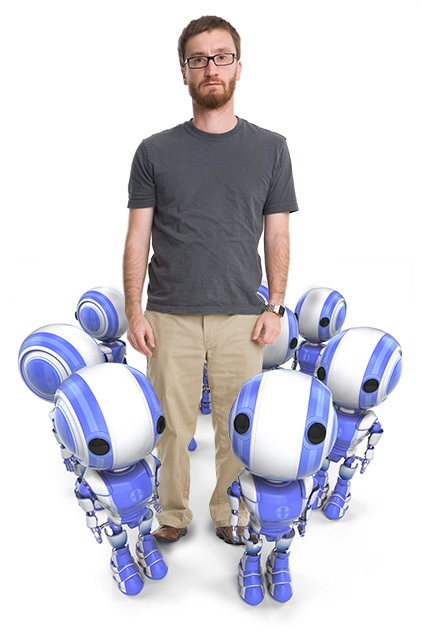If you are a regular visitor to ElectronicProducts.com, you could get the impression that robots are poised to take over. 
We can easily lose sight of an important mathematical fact: Each one of us is 3.02 x 1032 gigabytes of information, a number I got when doing an article on teleportation. A robot? The upgraded NASA R2 robot, with legs and new processors, will have a mere 20 gigabytes, according to Ron Diftler, NASA’s Robonaut Project Manager.
This is a significant difference. We can do a lot easy-peasy that take lots of programming of robots and other machines to match. But we are forced to think hard about what we do. The number of things that people alone can do is shrinking all the time. If each of us is to succeed in the world today, we need increasingly to understand what it is we do — and need to do. Machines take the routine tasks from us and free us to think and do creatively and imaginitively.
Let’s begin with the simplest of computing devices. A humble 8-bit microcontroller is tasked with asking and answering over and over the famous children’s question, “Are we there yet?” The microcontroller asks the question — and answers it (a bonus) — far more than the child. I hope no one is thinking of replacing children with microcontrollers.
A robot contains both microcontrollers and microprocessors, controlling electromechanical parts in the analog — that is, real — world so that they can do far more than ask and answer that annoying children’s question. A robot is a lot more complex than the venerable 8-bit microcontroller. I say “venerable” because it is hard to replace, even though 16- and 32-bit versions exist that do more complex tasks. Microcontrollers are designed to perform specific tasks, applications where the relationship of input and output is defined, such as a keyboard, mouse, washing machine, digital camera, pendrive, remote, microwave, car, bike, telephone, watches, and so on. Since the applications are very specific, they need small resources such as RAM, ROM, and I/O ports, and hence can be embedded on a single chip. This in turn reduces the size and the cost. A microprocessor, on the other hand, finds applications where tasks are unspecific like developing software, games, websites, photo editing, creating documents etc. In such cases the relationship between input and output is not defined. They need a high amount of resources such as RAM, ROM, and I/O ports.
Furby “learns,” thanks to a digital signal processor.
And the micro world (you use the word “micro” to mean both microcontroller and microprocessor) needs lots of programming. Some of it can be self-programming such as with a digital signal processor, a key component in a Furby, a children’s toy that “learns” – a scary proposition explored in movies such as War Games and the Arnold Schwarzenegger Terminator series.
Here’s where we —all 3.02 x 1032 GB of each one of us — clash with the robots, not only in the science fiction Terminator sense (I’ll come back to that thought), but in the everyday jobs we now have.
People have been replaced by machines for over 200 years at least, some of it thankfully and some of it not. We don’t want to stand in the way of progress the way the Luddites did in the 18th century. The Luddites were garment workers whose jobs were threatened by the introduction of mechanical looms. The Luddites smashed the looms in protest. Mechanical looms make less-expensive clothing possible. A good thing, yes?
Similar examples abound in transportation, communication, medicine, entertainment, warfare. The list could go on, limited I suppose only by imagination. Imagination is the stuff of science fiction, and if the 20th century is any indication, science fiction soon becomes science fact.
So humans — each one of us 3.02 x 1032 -GB beings — are being forced to rethink what we do. Can our jobs be replaced? Routine jobs can be. A mail carrier is faced with the reality that mail is now snail mail and e-mail, with e-mail winning. A toll collector exists only for those people who don’t have, or won’t have (there are reasons), an automated toll tag on their car such as EZ-Pass. A sales clerk can be replaced by a self-checkout system. A Roomba is a robotic vacuum cleaner. The Internet of Things automates functions previously done by humans with appliances such as refrigerators and washing machines, where the appliance can use the Internet to order food and maintenance. An automobile can park itself and schedule its own maintenance. The automobile that drives itself is not far off.
Medical and social services are being performed by robots. Even package delivery is not immune from robotics. The last bastion of the world of mail as we know it (yes, the U.S. Postal Service has competition from UPS and FedEx, but these are still human package-delivery services) is being threatened by robots — drones to be exact. Just recently used on the battlefield, drones are poised to deliver packages once they are legally allowed to do so.
None of what I have written is meant to be discouraging. We simply need to be aware that the things we create can compete with us — and we need to stay in the competition. A footnote to this thought comes from electronics commentator Andy Marken, just back from the recent Consumer Electronics Show, “We're still digesting all of the stuff we saw at CES and it'll take a week to get our report ready but we did notice a few things that stuck out like sore thumbs to us. The best keynotes (there were dozens), the best booths were those that were focused on the customer (the show visitor), not how great, how cool the company was. Funny how that works the places you want to spend the most time, associate with, buy from are the firms that aren't huge design wonders but human-centric.”
Advertisement





